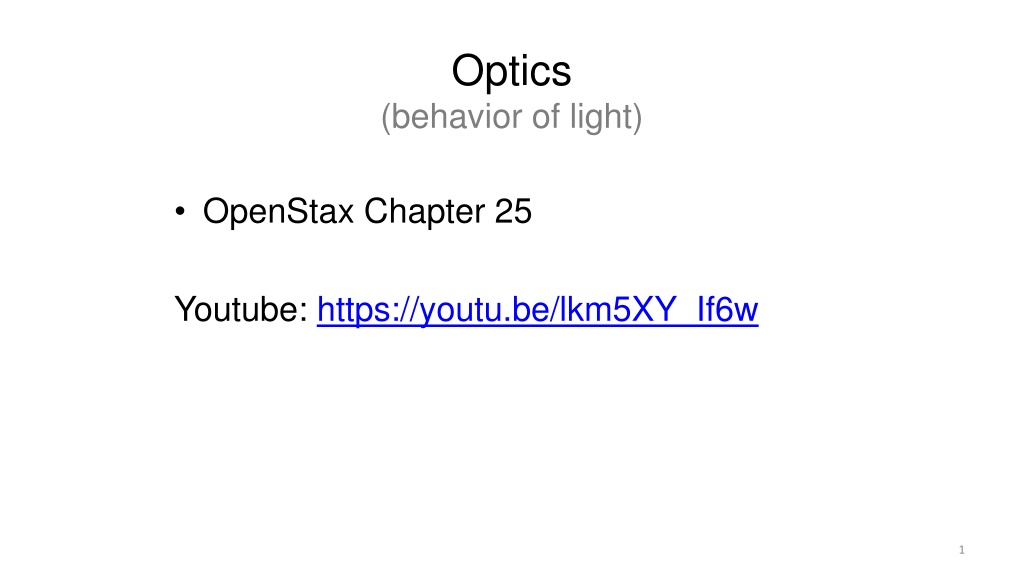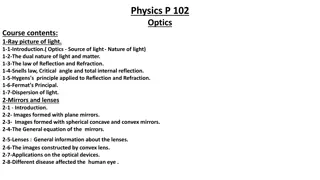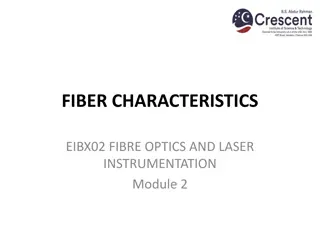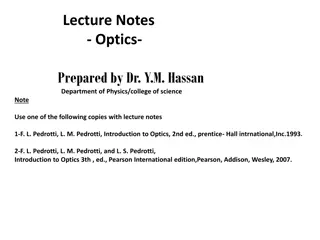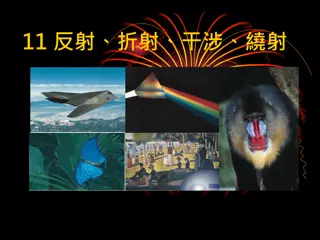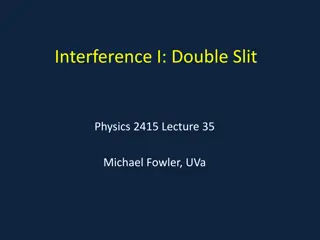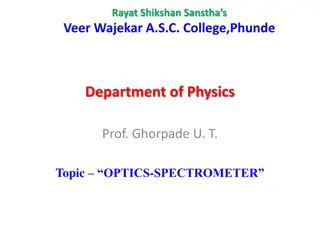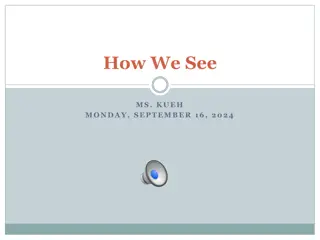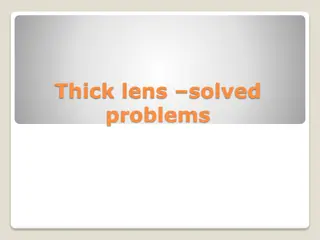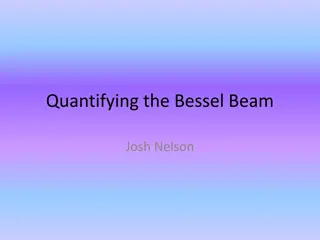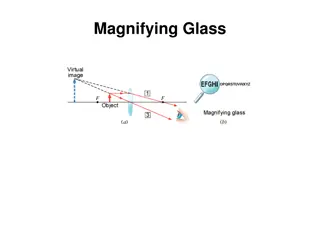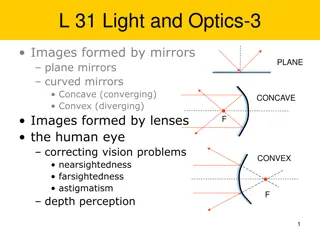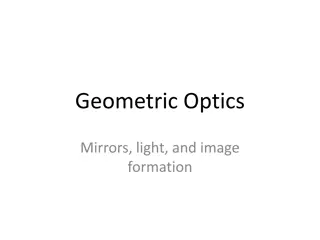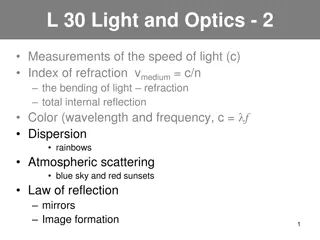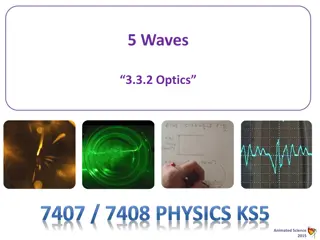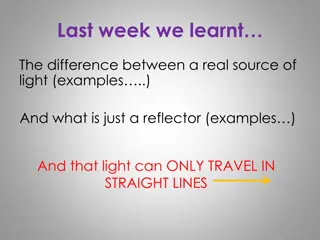Understanding the Behavior of Light in Optics
Light in optics can be described as a wave, a particle, or a ray. The ray model of light explains how light travels in straight lines unless it interacts with a surface or changes media. By tracing rays back, we can locate objects and understand how light interacts with matter at boundaries between mediums.
Uploaded on Sep 16, 2024 | 0 Views
Download Presentation

Please find below an Image/Link to download the presentation.
The content on the website is provided AS IS for your information and personal use only. It may not be sold, licensed, or shared on other websites without obtaining consent from the author. Download presentation by click this link. If you encounter any issues during the download, it is possible that the publisher has removed the file from their server.
E N D
Presentation Transcript
Optics (behavior of light) OpenStax Chapter 25 Youtube: https://youtu.be/lkm5XY_If6w 1
Describing Light There are several different ways to look at light: Light is a wave a particle with some velocity Light can be treated like a ray this is an approximation but it s where we ll start 2
OpenStax Chapter 25.1 Ray model of light Light travels in a straight line unless if it interacts with a surface / changes media 3
Ray Model What do we mean by that? Rays of light are the geometric kind of ray Reminder about rays: Start at point Point outward as straight line 4
Basic Ideas of Ray Model Light is represented as a collection of rays Light source produces an infinite number of rays (one in each direction) Object is detected when an observer collects the rays (for example rays enter the observer s eye) Rays travel in straight line unless they interact with matter http://en.wikipedia.org/wiki/File:RBG-LED.jpg 5
Light Sources (Light Production) Self-Luminous Objects (generate light) Reflective Objects (just reflect rays) Just about everything else Fire, electric lights, stars, some animals, etc. 1. Light bulbs in this room produce light rays 2. These rays bounce off this screen 3. The reflected rays enter the eye or other detector http://en.wikipedia.org/wiki/File:Firefly_composite.jpg 6
Rays and Objects Each object emits rays in all directions Object 1: know location, trace rays Object 2: What if you know rays trajectoriesbut not object s location? Rays can be traced back to find object s location When looking for images, trace rays back to find where they intersect 7
Rays and Matter When reaching a border between mediums (for example air to water), rays can Within a medium, light can Scatter (change direction) Be Absorbed (light s energy changes matter and ray ends) Reflect (stays in original medium) Refract (travel in new direction into new medium) 8
Reflection (OpenStax 25.2) Ray reaches surface at angle of incidence i Angle between ray and a normal (perpendicular) line from surface Ray bounces away from surface at angle of reflection r normal Laws of Reflection: 1. Rays and normal are in same plane 2. Those angles are equal: i= r i r (Stripes like this generally mean that second material is opaque) 9
Plane Mirrors Flat, shiny surface Light rays that impact on surface reflect off Observer can detect these rays http://en.wikipedia.org/wiki/File:Mirror.jpg Interpret the reflected rays as coming from the image Image location: where it looks like the reflected rays come from 10
Ray Diagram to Find Image 1. 2. Draw rays from light source Rays are straight unless if they encounter mirror Rays follow Law of Reflection at Mirror (i.e. i= r) Draw (dashed) line back from the reflected ray Image is located where the reflected rays trace back to intersect each other 3. 4. 5. Mirror Object Image Use dot for one point on object i r Reflected rays look like they came from image i r These are not the only rays that are emitted You need at least two rays in any ray diagram 11 Use three to help check your diagram
Where is the Image for a Plane Mirror? What we mean by image location: Place where it looks like all the reflected rays come from Brain interprets the rays by saying an appropriately sized thing is located there Image forms behind the mirror On normal line which passes through the object What do we mean by behind the mirror ? 12
How far back is the image? Does knowing where the object is tell us where the image is? Look at a single set of rays and include its normal line Law of Reflection says these are equal: The red and green triangles are congruent (i.e. same shape and size) Object i r i i r Image is as far behind the mirror as the object is in front of it These two are equal (they re vertical angles) 13 Image
Distance Terminology for Optics Object Distance: s this is distance from the mirror / surfaces / lens to the object in question Image Distance: s' this is distance from the mirror / surfaces / lens to the object s image Measured along a line perpendicular to the mirror/surface/lens (the optical axis will be more important when we deal with lenses and curved mirrors) s s' 14
Checking on Object and Image Locations 1. Which is s? 2. Which is the following is the image for the object? A normal B C D A B Extension of mirror C D E: None of them are s E: None of them are the image location (because they do not lie on the normal) 15
Types of Images Terminology Virtual image: one that is formed by the appearance that light rays originated there (i.e. formed by intersection of projected (dashed) rays) e.g. plane mirrors form virtual images Real image: one that is formed where light rays actually converge (i.e. formed by intersection of actual rays see section on lenses) Virtual Image Light actually is present at location of real image but no rays are actually present at location of a virtual image (for a mirror) 16
Mirror Image with Ray Diagram Why don t mirrors flip up and down? Side View For this non-point object: Rays come from each point of the object (and hit different parts of the mirror) This could have been an overhead view Image doesn t shift up or down (no flip up and down) There s also no left-right flip (Think about what you would say if there were no context clues) Each point on the image is in same place w.r.t. mirror as corresponding point on object 17
What if Object isnt Directly in Front of Mirror? no image formed if Bob stands here (on the opaque side) Someone standing here can see image Can an image still form? YES 1. Does Bob have to be in front of mirror (to the left in this figure)? YES 2. Can Bob see his image here? NO To create an image, an object must be located in front of the shiny side of the mirror (not on the opaque side) s s' Bob s Image Bob Extension of mirror 18
Who can see an Image ? We haven t worried about the location of an observer so far Whether or not someone sees an image depends on two main things (measured with respect to the mirror): For the observer to see an image, reflected rays must reach the observer Where the object is Where the observer is Next, we ll consider a small object in the middle of a mirror 19
Who can see an Image ? Ray Diagram Stand between reflections of extreme rays to see image Someone standing near the object should see image Reflections of extreme rays give limits of where observer can be and still see image 20
Who can see an Image ? Ray Diagram Stand between reflections of extreme rays to see image Someone standing directly behind the object should be able to see it s image So should someone standing near the object Limit for being able to see the image is that the observer is detecting extreme rays that just hit the mirror 21
Finding Last Person to See an Image In the figure, the mirror is 2 m long, and the object is 1 m away from its left edge. The dashed line is 0.5 m away from the mirror. How far to the right of edge of the mirror can someone standing on the line be and still see an image of the object? Law of Reflection says these are equal: x1 y1 x2 y2 i r So these are similar triangles (all angles equal) A. 2 m C. 0.25 m E. 1 m B. 0.5 m D. 4 m i.e. x1/x2 = y1/y2 22
What if You Have More than One Mirror? Method 1: Ray diagram Send at least two rays to each mirror Try to have at least two rays reflect off both mirrors 23
What if You Have More than One Mirror? Method 1: Ray diagram Send at least two rays to each mirror Try to have at least two rays reflect off both mirrors e.g. two rays that hit horizontal then vertical mirror and vice versa Keep following this process until rays escape 24
What if You Have More than One Mirror? Method 2: Image Location Find image from object and one mirror sv = 4 boxes for object and I From object and vertical mirror vertical mirror sh = 6 boxes for object and horizontal mirror sv' sv sh For first generation images sv' = 4 boxes for vertical mirror sh' = 6 boxes for horizontal mirror Use each image as an object with the other mirror sh' II From object and horizontal mirror 25
What if You Have More than One Mirror? Method 2: Image Location Using I (formed by object and vertical m.) and horizontal mirror I sI = 6 boxes (to extension) sI' = 6 boxes for III sI Using II (formed by object and horizontal m.) and vertical mirror sII = 4 boxes (to extension) sII' = 4 boxes for III (same position) sI' III is an image that does form, but Since III is behind both mirrors (i.e. facing the opaque sides)it won t create a fourth image II III sII sII' 26
Another Image Two Mirrors Making Multiple Images How do we deal with a situation with two (or more mirrors)? Yet Another Image Ray Diagram One Image Draw rays which follow the Law of Reflection Trace them back to find image(s) 27 (There will also be images down here)
Two Mirrors Making Multiple Images For object and Upper Mirror: s = d so |s'| = d How do we deal with a situation with two (or more mirrors)? Upper Mirror Image Location d d Find the object s image in one mirror Lower Mirror Use this as the object for the next mirror 28
Two Mirrors Making Multiple Images For this image and Mirror 2: s = 3d so |s'| = 3d How do we deal with a situation with two (or more mirrors)? d Image Location d d Find the object s image in one mirror Lower Mirror So far we have two images, we can keep going to get more 29
Two Mirrors Making Multiple Images These are the images we found so far Upper Mirror d We could have also started with an image formed by the object and Lower Mirror d d Lower Mirror Then use this image and Upper Mirror For the object and Lower Mirror: s = d so |s'| = d (More practice in recitation) 30
Geometry Techniques for Ray Optics Some come from Laws Use trigonometry for others (make a triangle first) Finding Angles Similar Triangles Side ratios are same If a = 2.4, = 3.6, b = 3.6, then = 5.4 Same shape, different size To identify b If two angles match, triangles are similar a Line through center is normal to circle when it reaches the edge Dealing with Circles 31
Why do Trucks Have Signs Like This? Light rays are reversible If Ray A follows some path Ray could follow the opposite path If rays get from me to you, then rays get from you to me http://static.seton.com/media/catalog/product/Truck- Safety-Signs-7258A-001-ba.gif 32
Curved Mirrors: Convex and Concave OpenStax Chapter 25.7 Convex Mirror Focal length is negative Image is virtual, upright, and reduced Concave Mirror Focal length is positive Image is either real and inverted virtual, upright, and enlarged 33
Spherical Mirrors Terminology Instead of a flat surface, mirrored surface is either the outside or inside of a (hollow) sphere We ll look at mirrors which are only a portion of the sphere (fairly flat disks instead of balls) Radius of Curvature: radius of the sphere which was used to make a mirror Convex Mirror Reflective side is on outside of sphere Concave Mirror Reflective side is on inside of sphere (looks like a cave ) (ray diagrams become a bit more complicated) 34
Curved Surface What would happen if we had a curved surface instead of a flat one? How to define an angle of incidence? First find the normal line Perpendicular at the point where the light ray in question reaches the surface i r Then use law of reflection: i= r (slide 9) What about a ray parallel to the first but hitting someplace else? The reflected ray travels in a different direction 35
Optical Axis and Focal Point Optical Axis (OA): line passing through middle of mirror and center of curvature (i.e. similar to extending the radius) (For plane mirrors f ) Center of Curvature: center of sphere used to make mirror (C) f F C Focal Length: measures from focal point to mirror (f) Focal Point: involved with reflection of rays parallel to optical axis (F) For fairly flat mirrors (stay near optical axis) focal length is related to radius of curvature (R) by: f= R / 2 36
Convex Mirrors: Ray Diagram Use three Special Rays to find images Each one obeys Law of Reflection 1st Ray 1. Ray which starts parallel to OA (i.e. optical axis) normal F C Note: with non-plane mirrors, must look at extended object (not single point) projected rays pass through F Reflected ray looks like it came from F 37
Convex Mirrors: Ray Diagram 2nd Ray 2. Ray which starts aimed at F (focal point) image extends from optical axis F C Reflected ray is parallel to the OA Note: This ray is the reverse of the first special ray (previous slide) 38
Convex Mirrors: Ray Diagram 3rd Ray 3. Ray which hits the mirror s center i r F C OA is the normal for this ray Reflected ray makes same angle with OA as the incident ray 39
